As a loving dog owner, you want to share every moment with your furry friend, including mealtime. However, many common household foods that are perfectly safe for humans can be incredibly dangerous, even toxic, to dogs. Understanding what not to feed dogs is crucial for their health and well-being. Pet poisonings are a significant concern, with hundreds of thousands reported annually in the United States alone. While not all incidents are food-related, everyday human foods are a major contributor to these alarming statistics.
This comprehensive guide serves as your essential “What Not To Feed Dogs List,” providing vital information on hazardous foods to avoid and outlining what foods can a dog have safely. By staying informed, you can help protect your beloved pet from potentially life-threatening situations and ensure they lead a happy, healthy life.
Why Certain Foods Are Toxic to Dogs
You might wonder why dogs cannot eat certain foods that are harmless to us. The fundamental reason lies in the significant differences between canine and human digestion and metabolism. Dogs’ bodies process certain substances in unique ways, making them vulnerable to compounds that we can easily handle.
For instance, theobromine and caffeine, found in chocolate, are metabolized much slower by dogs than by humans. This allows these substances to accumulate rapidly in their system, potentially leading to fatal consequences. Similarly, while cherries are a common human snack, the cyanide present in their pits, stems, and leaves can be problematic for dogs if consumed in large quantities. The pits themselves can also cause digestive issues like diarrhea due to their indigestible nature, making it safer to avoid them entirely.
It’s also important to note that food toxicity can vary based on a dog’s size, breed, and existing health conditions. A small amount of a toxic food might be more dangerous for a tiny breed than a large one. Therefore, if you ever have questions about specific foods or believe your dog has ingested something harmful, always consult your veterinarian immediately. They can provide expert advice on what food is ok for dogs to eat and guide you in emergency situations.
The Comprehensive What Not To Feed Dogs List: Dangerous Human Foods
Many everyday household foods pose serious dangers—and often toxicity—to dogs. While the list below highlights some of the most common and dangerous items, it’s not exhaustive. Always err on the side of caution if you’re unsure about a particular food.
1. Alcohol
Alcohol is significantly more dangerous for pets due to their smaller body size. Even minimal amounts can cause severe harm. The smaller the dog, the more perilous even a slight ingestion can be. Symptoms of alcohol poisoning in dogs mirror those in humans, including vomiting, breathing difficulties, coma, and even death.
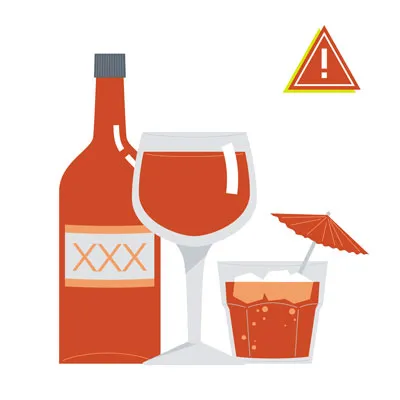 A close-up image of a full glass of beer with condensation, set against a blurred background.
A close-up image of a full glass of beer with condensation, set against a blurred background.
2. Apple, Apricot, Cherry, and Plum Seeds/Pits
While the flesh of apples is generally safe for dogs, the core and especially the seeds are not. Apple seeds contain cyanide, which, though likely harmless in very small doses, is best avoided altogether. Similarly, the seeds and pits of apricots, cherries, peaches, and plums are also hazardous. These fruit pits contain cyanide, which interferes with red blood cells’ ability to carry oxygen, leading to symptoms such as vomiting, an irregular and rapid heartbeat, seizures, coma, and death.
3. Avocado
Avocados are not a suitable choice for dogs. There have been documented cases of myocardial damage in dogs after consuming avocados. While these specific results haven’t been widely replicated, avocados are known to cause issues in other mammal species. Furthermore, an intact avocado pit can cause a dangerous obstruction in a dog’s gastrointestinal tract. Thus, it’s safest to keep this fruit away from your canine companion.
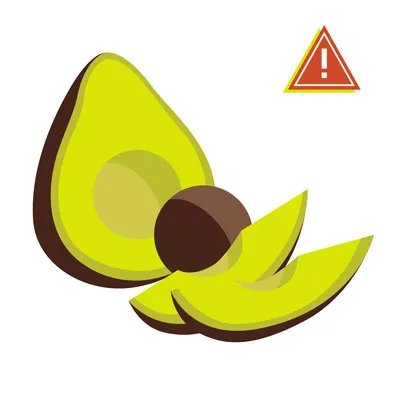 A sliced avocado with its pit clearly visible, placed on a dark surface, highlighting the creamy green flesh.
A sliced avocado with its pit clearly visible, placed on a dark surface, highlighting the creamy green flesh.
4. Broccoli
Broccoli contains isothiocyanates, which can be detrimental to pets when consumed in very large quantities. While small amounts occasionally might be acceptable, it’s generally best to avoid feeding broccoli to your dog, especially given the abundance of other healthy and safe food options. Additionally, broccoli stalks can sometimes pose a choking hazard or cause an obstruction in a dog’s throat.
5. Caffeine and Coffee Grounds
Caffeine contains methylxanthines, compounds that can lead to potentially fatal symptoms like diarrhea, vomiting, seizures, and an irregular heartbeat in dogs. If your dog accidentally ingests coffee grounds or drinks high-caffeine beverages, their heart rate can dangerously accelerate. This can precipitate tremors, arrhythmia, difficulty breathing, and other severe health issues.
6. Chicken and Turkey Skin, Ham, and Other Fatty Cuts of Meat
Fatty cuts of meat, including ham and rich items like chicken or turkey skin, should be discarded rather than offered as treats to pets. Their high-fat content can trigger acute pancreatitis, a life-threatening illness accompanied by severe complications.
It’s also critical to avoid giving dogs turkey and chicken bones. These bones can splinter, leading to obstructions in the bowels or damage to the stomach or intestines. In severe cases, they can puncture these organs, resulting in a fatal abdominal infection.
7. Chocolate
Chocolate toxicity is a frequent cause of pet poisoning, especially during festive periods. No chocolate product is safe for your dog to eat! Chocolate contains theobromine, a lethal component—the darker the chocolate, the higher its concentration. Chocolate also contains caffeine, and some sugar-free variations may even include xylitol, which is highly toxic to dogs. Dogs and cats cannot metabolize chocolate as efficiently as humans. Dark chocolate and baker’s chocolate are the most dangerous forms, but any type of chocolate can be problematic.
Symptoms of chocolate ingestion can include hyperactivity, vomiting, diarrhea, pancreatitis, abnormal heart rhythms, and seizures. If your dog consumes any amount of chocolate, no matter how small, contact your veterinarian immediately.
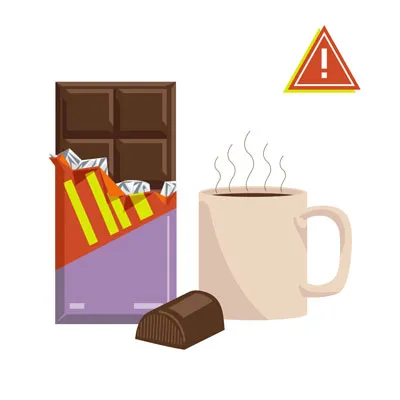 A stack of various chocolate bars and pieces, ranging from dark to milk chocolate, suggesting different forms of the treat.
A stack of various chocolate bars and pieces, ranging from dark to milk chocolate, suggesting different forms of the treat.
8. Grapes and Raisins
Grapes and raisins are exceptionally dangerous for dogs. These fruits can cause severe kidney failure because their tartaric acid is toxic to canine kidneys. Even a few bites are enough to wreak havoc on your dog’s system. Symptoms of raisin or grape poisoning include vomiting, diarrhea, loss of appetite, changes in urine output (from excessive to none), or complete inability to urinate.
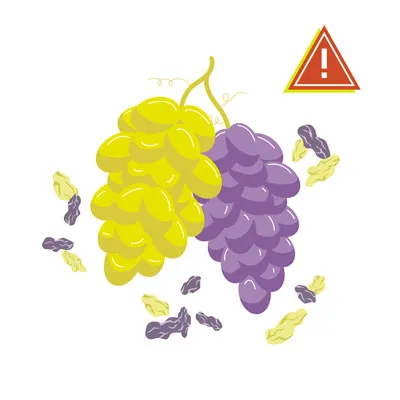 A small bunch of fresh green grapes with leaves, positioned against a light background.
A small bunch of fresh green grapes with leaves, positioned against a light background.
9. Macadamia Nuts, Almonds, and Pistachios
Macadamia nuts can cause a range of painful symptoms in dogs, including weakness, overheating, and vomiting. Although the precise mechanism of poisoning remains somewhat mysterious, these nuts are definitively considered toxic to dogs. As few as six macadamia nuts can induce severe poisoning in a small dog.
While macadamia nuts are the most dangerous, other nuts like pistachios and almonds can also pose risks due to being choking hazards, especially if they are flavored or spiced. For more guidance on what human food can my dog eat, always consult reliable sources.
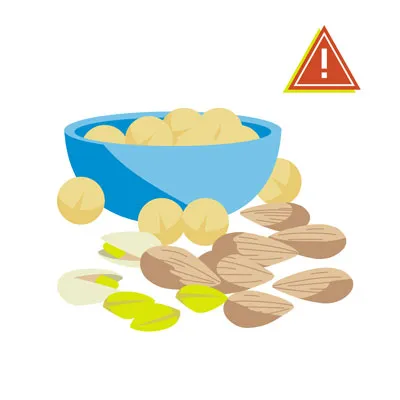 A small pile of macadamia nuts, some still in their shells, on a light-colored surface.
A small pile of macadamia nuts, some still in their shells, on a light-colored surface.
10. Milk and Dairy Products
The suitability of milk and other dairy products for dogs should be assessed on a case-by-case basis. Some dogs can tolerate them without issue, while others are lactose intolerant or allergic, experiencing diarrhea and gas from cow’s milk.
Ice cream is generally bad for dogs due to its high sugar and fat content. As a healthier alternative, consider freezing small pieces of safe fruits for your dog. Cheese, in small quantities, is usually acceptable, but opt for lower-fat varieties as occasional treats.
11. Mushrooms
It’s always best to err on the side of caution and avoid feeding your dog any mushrooms. Wild mushrooms contain various toxins that can lead to kidney and liver failure, vomiting, diarrhea, hallucinations, and damage to red blood cells. While commercially grown white button mushrooms from the grocery store might be okay, it is generally safer to choose a different, unequivocally safe treat for your pet.
12. Nutmeg and Cinnamon
Dogs should never be given foods containing nutmeg. This spice can induce severe vomiting and even hallucinations. Even if your dog begs for a nutmeg-spiced treat, resist the urge. The compound responsible is myristicin, and its effects are more pronounced in higher doses or when consumed by smaller dogs. If any amount of nutmeg is ingested, contact your veterinarian for advice.
Cinnamon should also be avoided. While not inherently toxic, it can irritate your dog’s mouth and, in some cases, lead to low blood sugar, which can have serious health implications.
13. Onions, Garlic, Chives, and Leeks
Many pet owners are surprised to learn that herbs from the allium family—including onions, garlic, chives, and leeks—are highly unsafe for their dogs. These plants contain sulfoxides and disulfides, which can damage red blood cells and cause anemia in both dogs and cats. Onion and garlic powders are common ingredients in many processed foods, even baby food, so it’s essential to meticulously read labels before offering any store-bought items to your pet. All allium plants can cause potentially fatal anemia in canines. Certain Japanese breeds, such as Akitas and Shiba Inus, are particularly sensitive, but these plants are dangerous for all dogs.
 A close-up of a white onion, several cloves of garlic, and fresh green chives arranged on a wooden surface.
A close-up of a white onion, several cloves of garlic, and fresh green chives arranged on a wooden surface.
14. Salt
Excessive salt intake can disrupt the fluid balance in your dog’s cells. Too much salt can lead to tremors, seizures, diarrhea, or even a coma. Whether it’s rock salt, homemade play dough, or potato chips, do not let your dog’s pleading eyes put their health at risk.
15. Spicy Food
Always keep your dog away from spicy foods. Hot, spicy ingredients can cause vomiting, stomach ulcers, or diarrhea, leading to considerable discomfort for your pet and potentially costly emergency vet visits.
16. Sugar-Free Gum and Candy (Xylitol)
Xylitol is an artificial sweetener found in numerous human products, including sugar-free gum, candy, and baked goods. In dogs, it causes a rapid and dangerous drop in blood sugar, leading to weakness and seizures. Some dogs may also develop liver failure. Dog poisoning cases involving xylitol are on the rise. The amount of xylitol in just five pieces of gum has the potential to be lethal for a 65-pound dog.
17. Tomatoes and Raw Potatoes
Tomatoes and potatoes fall into a category of foods that are safe in some forms but unsafe in others. A ripened red tomato is generally fine for dogs. However, the green parts of the tomato plant, along with unripe green tomatoes, contain solanine, which is toxic to dogs.
Potatoes follow a similar rule. Baked or boiled potatoes without additives are generally safe in small quantities. However, raw potatoes also contain solanine, making them toxic to dogs.
18. Tobacco
Tobacco is extremely dangerous and unhealthy for your dog. Exposure to nicotine-containing products can induce a wide array of symptoms, including vomiting, diarrhea, rapid or labored breathing, agitation, abnormal heart rate, wobbliness, muscle weakness, fluctuating blood pressure, seizures, and tremors. More significant or frequent exposure can lead to blue gums, coma, and ultimately prove fatal.
Dogs are naturally curious. They might encounter a discarded cigarette on a walk or investigate an ashtray. If your dog ingests any tobacco, immediate veterinary attention is critical.
19. Yeast and Raw Dough
Yeast and raw dough are unsafe for dogs for multiple reasons. Raw dough can expand significantly in a dog’s stomach, causing severe pain and potentially life-threatening conditions like torsion or rupture of the stomach. Additionally, the yeast and sugar in raw dough can ferment, producing alcohol and leading to alcohol toxicity. This condition can rapidly become fatal and necessitates immediate medical intervention.
20. Raw Meat
Never feed your dog raw or undercooked meat. Raw meat can carry harmful bacteria like Salmonella or E. coli, which can sicken dogs just as they do humans. Furthermore, bones in raw meat pose a significant choking hazard.
21. Rhubarb
Rhubarb, often used in desserts, is not safe for pets. Its leaves contain soluble calcium oxalate crystals. Ingested in sufficient quantities, these crystals can bind with calcium in the dog’s body, causing a dangerous drop in calcium levels and potentially leading to renal failure. Symptoms include tremors, weakness, drooling, bloody urine, changes in thirst and urination, and vomiting.
22. Star Fruit
Similar to rhubarb, star fruit also contains soluble calcium oxalate crystals. Therefore, it’s best to prevent your dog from snacking on this fruit.
23. Flavored and Seltzer Water
When it comes to your dog’s hydration, always prioritize fresh, clean water over anything flavored or carbonated. Seltzer and flavored waters can contain added ingredients that are dangerous to pups, such as sugar or excessive salt. Plain seltzer water might be acceptable in very small amounts if urgently needed, but it can still lead to gas and bloating. Sticking to plain water is always the safest option.
What Dogs Are Most at Risk if They Consume Toxic Foods?
While all dogs should be protected from toxic foods, some are at a higher risk if exposure occurs:
- Small breeds vs. large breeds: Smaller dogs are more vulnerable due to their lower body weight, especially when dealing with substances like chocolate.
- Puppies: Younger dogs have less developed digestive and immune systems, making them more susceptible to certain substances. This also applies to considerations like raw dog food.
- Elderly dogs: Older dogs may face higher risks due to pre-existing health conditions. For example, dogs with other health issues should generally avoid raw dog food.
- Dogs with pre-existing conditions: Many existing health conditions, such as diabetes or kidney disease, can significantly increase a dog’s risk when exposed to toxic foods. Understanding your dog’s specific needs, including what to give a sick puppy to eat, is critical for their care.
How to Prevent Your Dog from Eating Dangerous Foods
While accidents can happen, proactive measures can significantly reduce the risk of your beloved pup encountering unsafe human foods.
1. Store Foods Out of Reach
Ensure that all toxic foods are inaccessible to your dog. Keep dangerous items on high shelves or securely locked away in cabinets that your pet cannot open.
2. Avoid Feeding from Your Plate
Resist the urge to feed your dog from your plate or while you are cooking in the kitchen, even if it’s just a small treat. The safest practice is to only offer treats specifically formulated and approved for dogs. This consistency helps prevent your dog from associating human meal times with potential treats.
3. Educate Family Members and Guests
It’s vital to educate everyone in your household, including children, and any guests about the dangers of feeding human food to your dog. Emphasize that no matter how tempting it is, they should never sneak food to your pet. Clear communication can prevent accidental poisonings. This is especially true for young puppies; for instance, knowing what can a one month old puppy eat means understanding that most human foods are off-limits.
4. Be Extra Cautious During Holidays
Be especially vigilant during holidays and celebrations. The hustle and bustle of these occasions can make it easy to lower your guard while cooking or entertaining. Keep all festive foods and treats securely out of your dog’s reach. If, despite your precautions, your dog consumes something toxic, rapid action is crucial. Always have readily available contact information for 24/7 emergency veterinarians and poison control centers, including during holidays.
What to Do if Your Dog Eats Something Toxic
If your dog consumes toxic food, seek professional help as quickly as possible.
Familiarize yourself with the symptoms of food toxicity so you can promptly recognize if your dog has eaten something harmful. Symptoms vary depending on the substance ingested but can include listlessness, distress, pain, vomiting, bloody stools, or a bloated, hard-to-the-touch stomach. This painful bloating can lead to stomach rupture if not treated urgently.
If you observe these symptoms, take the following steps:
- Call your veterinarian or poison control immediately. Time is of the essence. Treatments are generally more successful, and hospitalization periods shorter, if a dog receives prompt medical attention.
- Be prepared with critical information. This includes the type of food eaten, the estimated amount consumed, and the time of ingestion.
- Avoid home remedies unless specifically advised by your veterinarian. The appropriate remedy depends entirely on what was eaten, and attempting to induce vomiting can sometimes be more harmful than helpful.
Dog Care Story Can Help You Keep Your Dog Healthy
Navigating the world of household toxins and dangerous foods can be challenging. Dogs, with their often indiscriminate tastes (some even eat their own poop!), require vigilant care. However, by adhering to this comprehensive guide and maintaining constant watch, you can effectively safeguard your dog from foods that could cause them harm.
The good news is that there’s an extensive list of safe and healthy foods that your dog can enjoy! Discover which approved treats your dog loves and offer them as rewards for good behavior. When in doubt about any food item, always consult your veterinarian for expert advice.
Pet insurance is an excellent way to prepare for unexpected encounters with toxins. At Dog Care Story, our pet insurance plans can be tailored to your pet’s unique needs. Additionally, many pet insurance providers offer a 24/7 pet helpline, allowing you to speak with a veterinary expert anytime you’re concerned about something your pet may have ingested.
References/Citations
- “Top 10 dog poisons,” Hilary Parker (5/2023), WebMD.
- “What happens if a dog eats chocolate?” (10/2023), Colorado State University.
- “Fruits and vegetables dogs can or can’t eat,” (3/2024), American Kennel Club.
- “What to do if your dog drinks alcohol,” Jerry Klein (7/2023), American Kennel Club.
- “Can dogs eat apples?” Hector Joy (12/2022), PetMD.
- “Can dogs eat plums?” Katie Koschalk (7/2023), Chewy.
- “Avocado (Persea spp) Toxicosis in Animals,” Cristine Hayes (9/2024), Merck Veterinary Manual.
- “People foods to avoid feeding your pets,” (n.d.), ASPCA.
- “People foods dogs can and can’t eat,” (3/2024), American Kennel Club.
- “Can dogs eat nuts?” Amanda Ardente (1/2023), PetMD.
- “Can dogs drink milk?” Sandra C. Mitchell (1/2024), PetMD.
- “Can dogs have nutmeg?” Barri J. Morrison (11/2023), PetMD.
- “Onion, garlic, chive, and leek poisoning in dogs,” Renee Schmid et al. (2024), VCA Animal Hospitals.
- “Can dogs eat tomatoes?” Anna Burke (10/2024), American Kennel Club.
- “Can dogs eat potatoes?” Katherine Ripley (11/2023), American Kennel Club.
- “What to do if your dog eats a cigarette butt,” (6/2023), American Kennel Club.
- “Dough & dogs: Why it’s bad and what you can do,” Lisa Goldstein (7/2024), Preventive Vet.
- “Rhubarb,” (n.d.), Pet Poison Helpline.
- “Can dogs drink carbonated water?” Heather Logue (n.d.), Rover.
- “What fruits can dogs eat?” Ellen Malmanger (2/2024), PetMD.
- “Can dogs have green beans?” Anna Burke (8/2022), American Kennel Club.
- “About pet food safety,” (4/2024), CDC.
